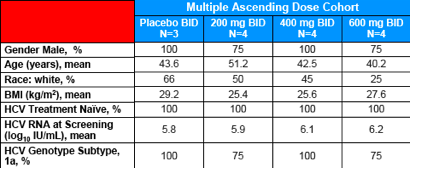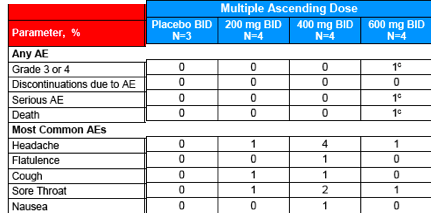 |
 |
 |
| |
Safety, Tolerability, Pharmacokinetics and Antiviral Activity following Single- and Multiple-Dose Administration of BMS-650032, a Novel HCV NS3 Inhibitor, in Subjects with Chronic Genotype 1 HCV Infection
|
| |
| |
Reported by Jules Levin
20th Conference of the APASL, China National Convention Center, 25 - 28 March 2010, Beijing, China. Poster #381
Claudio Pasquinelli1 Timothy Eley1, Criselda Villegas1, Katrina Sandy1, Elton Mathias1, Pamela Wendelburg1, Shanmei Liao1, Fiona McPhee1, Paul Scola1, Li-Qiang Sun1, Thomas C Marbury2,
Eric Lawitz3, Ronald Goldwater4, Maribel Rodriguez-Torres5, Michael P DeMicco6, Michelle Ababa7, David Wright8, Michael Charlton9, Walter K Kraft10, Juan Carlos Lopez-Talavera1, Dennis M. Grasela1
1Bristol-Myers Squibb, Research and Development, Princeton, NJ, USA; 2Orlando clinical research center, Orlando, FL, USA; 3Alamo Medical Research, San-Antonio, TX, USA; 4PARAXEL Int, Clin Pharm Research Unit, Harbor Hospital Center, Baltimore, MA, USA;
5Fudación de Investagición de Diego, Santurce, PR, USA; 6Advanced Clinical Research Inst, Anaheim, CA, USA; 7West Coast Clinical Trials, Cypress, CA, USA; 8Central Texas Clinical Research, Austin, TX, USA;
9Mayo Clinic, Division of GI & Hepatology Transplant Center, Rochester, MO, USA; 10Thomas Jefferson University, Dept. of Pharmacology and Experimental Therapeutics, Philadelphia, PA, USA

BACKGROUND
BMS-650032 is a potent and selective HCV NS3/4A protease inhibitor with broad genotype coverage
- EC50: Genotype 1a (4 nM); Genotype 1b (1 nM)
In vitro: synergistic with IFN-α and other HCV inhibitors
In a single ascending dose study in healthy non-HCV infected subjects, BMS-650032:
- Was safe and well-tolerated
-- Had a pharmacokinetic (PK) profile suggesting the possibility of twice-daily dosing







SAFETY
BMS-650032 was not associated with AE-related treatment discontinuations or serious adverse events in either the SAD or MAD studies
No clinically relevant impact on vital signs, physical examinations, ECG's or clinical laboratory tests
Single and multiple doses of BMS-650032 were generally safe, well-tolerated and had a safety profile similar to that of placebo


a1 patient had a seizure and interrupted placebo treatment (pre-existing condition epilepsy)
b1 patient with atypical chest pain who was later diagnosed with ALS and died 2 months later
c1 patient with acute renal failure and metabolic acidosis following amphetamine toxicity
Figure 2: BMS-650032 Pharmacokinetics following Single Dosing


Figure 3: BMS-650032 AUC in HCV+ Subjects and in
Normal Healthy Volunteers (NHV) following Single Dosing

Figure 4: Mean Change in HCV RNA (SAD)




|
| |
|
 |
 |
|
|